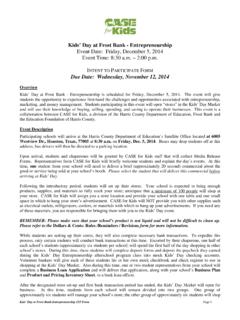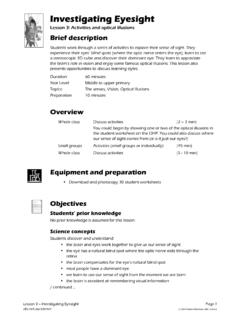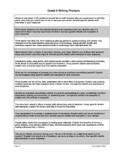Transcription of KIDS DAY O T C F S HE ASE ORENSIC CIENCE
1 KIDS DAY SERIES ON THE CASE: FORENSIC SCIENCE Harris County Department of Education | Cooperative for After-School Enrichment Forensic Science 1 Table of Contents Curriculum Unit Overview .. 2 Lesson One: Forensic Introduction/Crime Overview .. 4 Lesson Two: Microscopic Fiber Analysis .. 10 Lesson Three: Powerful Powders .. 19 Lesson Four: The Parting of the Pen .. 25 Lesson Five: Stepping Up to the Suspects .. 30 Lesson Six: LIPSTICK FUSION .. 37 Lesson Seven: Hair Do or Don t? .. 43 Lesson Eight: It All Points to Guilty .. 48 Final Community Park Crime Report .. 53 Forensic Science 2 Curriculum Unit Overview Participating students (primarily designed for 3rd-6th grade but applicable for middle school as well) will use forensic science techniques to preserve physical evidence and solve a fictional crime.
2 Students will also be given the opportunity to learn from forensic science professionals and put their newly-acquired forensic science skills to work in simulated lessons. Instructional Period Topic Objectives Week 1 Forensic Introduction/ Forensic 101 Students will observe physical features, requiring them to utilize methods of thinking to investigate and construct solutions. Week 2 Microscopic Fiber Analysis Students will utilize the microscope to analyze different types of fibers by using a microscope to identify a suspect. Week 3 Powder Properties/ Powder Analysis Students will learn to preserve physical evidence by observing physical properties and chemical reactions.
3 Week 4 The Parting of the Pen/ Ink Analysis Students will understand chromatography a process used in crime investigations to separate a material from a mixture Week 5 Stepping Up To the Suspects/ Foot Print Analysis Students will focus on collecting data. Week 6 Lipstick Fusion/ Lip Print Analysis Students will learn to classify and analyze lip prints to find a suspect in a crime investigation. Week 7 Hair Do or Don t/ Hair Analysis Students will utilize hair strands to identify forensic analysts. Week 8 It All Points to Guilty Students will rely on fingerprinting to compare possible suspects.
4 Forensic Science 3 Forensic Science 4 Lesson One: Forensic Introduction/Crime Overview Lesson 1 Topic: Forensic 101 Lesson Objective: Students will learn about the study of forensic investigation and begin to evaluate the details of the community crime they will assist in evaluating. Students will learn what it means to write a hypothesis and draw inferences from available details. Targeted Grade Level: 3-5th, Middle School Anticipated Time: 60-75 minutes Description Standards TEKS: Science (A) plan and implement descriptive investigations, including asking and answering questions, making inferences, and selecting and using equipment or technology needed, to solve a specific problem in the natural world; (B) collect data by observing and measuring using the metric system and recognize differences between observed and measured data.
5 (C) construct maps, graphic organizers, simple tables, charts, and bar graphs using tools and current technology to organize, examine, and evaluate measured data; (D) analyze and interpret patterns in data to construct reasonable explanations based on evidence from investigations MATERIALS Paper pen/pencil class set of Books- Seeing the Evidence: Forensic Scientists at Work (if possible) Teachers can register at for a free trial and search the book title to print class set of books. poster paper chalk board computer projector internet SET-UP Grouping: Divide the class into 4 groups (these groups will remain over the course of the curriculum) Arrange classroom so students may sit in group setting Make sure all students are seated so they can see the instructor Place materials for the day on a table where the teacher and student can easily access them OPENING Begin the class by introducing yourself and explain to students that over the next 8 weeks they will work with the police department to determine if the presented individuals are indeed responsible suspects for in the community park crime.
6 Explain to students that they will learn about Forensic Science and gain important skills needed to be a Forensic investigator. LESSON INTRODUCTION Begin lesson by asking students if any of them have ever thought about Modifications Output- Adapt how the student can respond to written responses such as allowing verbal responses, or use a journal book to allow students to show knowledge with diagrams. Resource Seeing the Evidence: Forensic Scientists at Work is an informational book about the science of analyzing types of evidence found at crime scenes. The book provides a historical overview of the first forensic scientists in the early 1900s.
7 Forensic Science 5 becoming a police officer or working for the FBI? (allow for no more than a minute response) Explain that over the next 8 weeks they will learn skills needed to become an investigative police officer or Forensic FBI agent. Provide each student with an Investigative Notebook. Instruct students to immediately write their name on the cover and turn to the Community Crime Profile. Teacher will read the profile (page 7 of this manual) to the students and inform them that by supporting the police department in their investigation they will also learn important forensic skills.
8 Teacher should explain that it is important for students to pay close attention over the next 8 weeks because at the end of the program they will work in groups to solve another crime on their own and will need to know how to conduct a proper investigation. (this is referring to the culminating event) Icebreaker (view supplemental sheet lesson 1A): Since students will be working very closely over the next 8 weeks it is important for them to get to know one another. As the teacher, if you are not yet familiar with students or if they are not familiar with each other, use Two Facts and A Falsehood (supplement p.)
9 6 of this manual). This activity will support and encourage students ability to analyze details and make sound conclusions. Extensions: Critical Thinking Warm Up Teacher should read the critical extension scenario below to encourage the students to think critically and practice analyzing information. (Extension can be placed on the board) There was nothing Leon, the driver passing by the park could do about the group of teens trashing the park. He d left his cell phone at home and it was very dark. Leon knew the popular community park had been totally demolished. After he arrived home, he called the police and reported the little bit he had seen.
10 What questions would the police need to ask Leon to begin investigating the community park crime? Allow students a few minutes to discuss the potential questions in a small group setting. Teacher should then lead group discussion and write the group responses on the board. Explain that over the course of this program students will learn how to investigate details like this. Introduce them to a few of the following guiding questions that students or professionals may use to guide investigations. Guiding Questions: (teacher may use all or some of these questions) How many individuals were involved?






